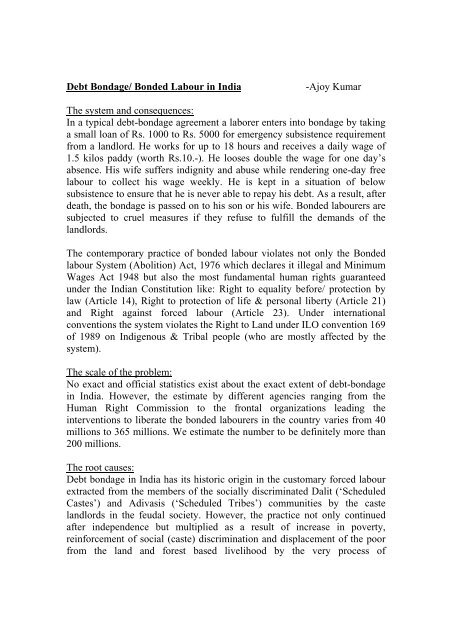Debt Bondage/ Bonded Labour in India -Ajoy Kumar ... - Fastenopfer
Debt Bondage/ Bonded Labour in India -Ajoy Kumar ... - Fastenopfer
Debt Bondage/ Bonded Labour in India -Ajoy Kumar ... - Fastenopfer
You also want an ePaper? Increase the reach of your titles
YUMPU automatically turns print PDFs into web optimized ePapers that Google loves.
<strong>Debt</strong> <strong>Bondage</strong>/ <strong>Bonded</strong> <strong>Labour</strong> <strong>in</strong> <strong>India</strong><br />
-<strong>Ajoy</strong> <strong>Kumar</strong><br />
The system and consequences:<br />
In a typical debt-bondage agreement a laborer enters <strong>in</strong>to bondage by tak<strong>in</strong>g<br />
a small loan of Rs. 1000 to Rs. 5000 for emergency subsistence requirement<br />
from a landlord. He works for up to 18 hours and receives a daily wage of<br />
1.5 kilos paddy (worth Rs.10.-). He looses double the wage for one day’s<br />
absence. His wife suffers <strong>in</strong>dignity and abuse while render<strong>in</strong>g one-day free<br />
labour to collect his wage weekly. He is kept <strong>in</strong> a situation of below<br />
subsistence to ensure that he is never able to repay his debt. As a result, after<br />
death, the bondage is passed on to his son or his wife. <strong>Bonded</strong> labourers are<br />
subjected to cruel measures if they refuse to fulfill the demands of the<br />
landlords.<br />
The contemporary practice of bonded labour violates not only the <strong>Bonded</strong><br />
labour System (Abolition) Act, 1976 which declares it illegal and M<strong>in</strong>imum<br />
Wages Act 1948 but also the most fundamental human rights guaranteed<br />
under the <strong>India</strong>n Constitution like: Right to equality before/ protection by<br />
law (Article 14), Right to protection of life & personal liberty (Article 21)<br />
and Right aga<strong>in</strong>st forced labour (Article 23). Under <strong>in</strong>ternational<br />
conventions the system violates the Right to Land under ILO convention 169<br />
of 1989 on Indigenous & Tribal people (who are mostly affected by the<br />
system).<br />
The scale of the problem:<br />
No exact and official statistics exist about the exact extent of debt-bondage<br />
<strong>in</strong> <strong>India</strong>. However, the estimate by different agencies rang<strong>in</strong>g from the<br />
Human Right Commission to the frontal organizations lead<strong>in</strong>g the<br />
<strong>in</strong>terventions to liberate the bonded labourers <strong>in</strong> the country varies from 40<br />
millions to 365 millions. We estimate the number to be def<strong>in</strong>itely more than<br />
200 millions.<br />
The root causes:<br />
<strong>Debt</strong> bondage <strong>in</strong> <strong>India</strong> has its historic orig<strong>in</strong> <strong>in</strong> the customary forced labour<br />
extracted from the members of the socially discrim<strong>in</strong>ated Dalit (‘Scheduled<br />
Castes’) and Adivasis (‘Scheduled Tribes’) communities by the caste<br />
landlords <strong>in</strong> the feudal society. However, the practice not only cont<strong>in</strong>ued<br />
after <strong>in</strong>dependence but multiplied as a result of <strong>in</strong>crease <strong>in</strong> poverty,<br />
re<strong>in</strong>forcement of social (caste) discrim<strong>in</strong>ation and displacement of the poor<br />
from the land and forest based livelihood by the very process of
development plann<strong>in</strong>g, liberalization and globalization. So, while <strong>India</strong><br />
sh<strong>in</strong>es <strong>in</strong> some quarters for its ‘economic achievements’ and ‘high growth<br />
rate’ its poorest languishes <strong>in</strong> worse poverty. They not only cont<strong>in</strong>ue to fall<br />
victim to the traditional form of debt bondage <strong>in</strong> agricultural sector but are<br />
also forced to migrate <strong>in</strong>to the contemporary forms of debt bondage <strong>in</strong> other<br />
sectors of economy like: brick kilns, textile, construction, plantations and<br />
domestic work etc.<br />
The legislation:<br />
<strong>India</strong> has been the first country <strong>in</strong> South Asia to enact the most progressive<br />
law: The <strong>Bonded</strong> <strong>Labour</strong> System (Abolition) Act, <strong>in</strong> the year 1976 to legally<br />
abolish the practice of debt bondage <strong>in</strong> any form, <strong>in</strong> the country. The law<br />
provides clear criteria for identification of the bonded labour, mechanism for<br />
their release and rehabilitation by the state and penal action for the offenders<br />
by designat<strong>in</strong>g the implement<strong>in</strong>g authorities and requir<strong>in</strong>g the establishment<br />
of vigilance committees for the purpose, <strong>in</strong> all districts of the country.<br />
The measures taken:<br />
The first 15 years after the enactment of the law witnessed a flurry of<br />
<strong>in</strong>terventions by the NGOs/ Civil society, judicial activism by the highest<br />
court of the land and a pronounced political will by the central government<br />
to implement the law seriously. Despite hard resistance posed by the<br />
feudalistic bureaucracy and adm<strong>in</strong>istrative harassment at the local level, the<br />
efforts succeeded <strong>in</strong> releas<strong>in</strong>g and rehabilitat<strong>in</strong>g about 2,50,000 bonded<br />
labourers (up to March 1993) all over <strong>India</strong>.<br />
The next 15 years (from 1993 till to date) -the era co<strong>in</strong>cid<strong>in</strong>g with the<br />
liberalization and globalization however, witnessed a steep decl<strong>in</strong>e <strong>in</strong> the<br />
political will and activism to address the issue seriously. The sluggish and<br />
half-hearted efforts could result <strong>in</strong> release and rehabilitation of a mere 30 to<br />
35,000 bonded labourers across the country. The state euphoria with ‘market<br />
solution’ to the problem of poverty and <strong>in</strong>creas<strong>in</strong>gly greater <strong>in</strong>tegration of<br />
NGOs <strong>in</strong>to the Micro F<strong>in</strong>ance –as the new approach to poverty eradication<br />
has resulted <strong>in</strong> abandonment of ‘human right’ and ‘justice’ based<br />
<strong>in</strong>terventions, seriously underm<strong>in</strong><strong>in</strong>g the potential for eradication of bonded<br />
labour.<br />
Our experience:<br />
Our experience with the struggle of bonded labourers <strong>in</strong> the state of<br />
Chhattisgarh which resulted <strong>in</strong> one of the most successful example of release
and rehabilitation of a large number of bonded labourers (about 6000)<br />
through the <strong>in</strong>tervention of Supreme Court of <strong>India</strong>, taught us the follow<strong>in</strong>g<br />
lessons:<br />
• Existence of the law and legal <strong>in</strong>tervention though crucial, is not<br />
sufficient <strong>in</strong> itself.<br />
• Mobilization and accompaniment by NGO/ civil society is imperative<br />
for effective release and rehabilitation of bonded labourers.<br />
• Resistance, reprisal and harassment by the creditors and local<br />
political-bureaucracy comb<strong>in</strong>e face any <strong>in</strong>tervention.<br />
• Land based livelihood (<strong>in</strong> case of agricultural bonded labourers) as<br />
long term rehabilitation measure is crucial for effective rehabilitation.<br />
• Creation of alternative credit facility by “group-sav<strong>in</strong>g” and overall<br />
empowerment is necessary to make release and rehabilitation<br />
susta<strong>in</strong>able.<br />
(The whole process of struggle up to the stage of the first/ historic<br />
<strong>in</strong>tervention of the Supreme Court of <strong>India</strong> order<strong>in</strong>g release and<br />
rehabilitation of 693 bonded labourers is documented <strong>in</strong> the attached<br />
booklet.)






